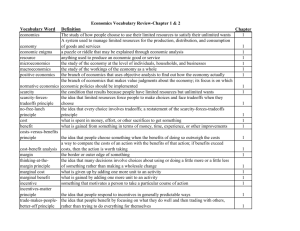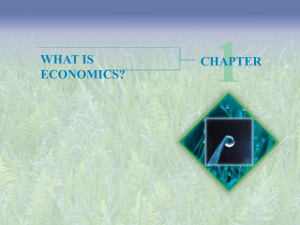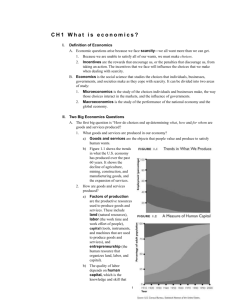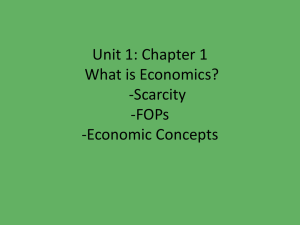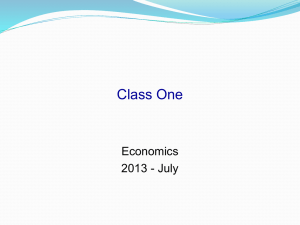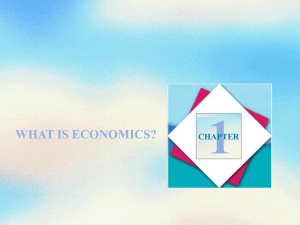Chapter 1
advertisement
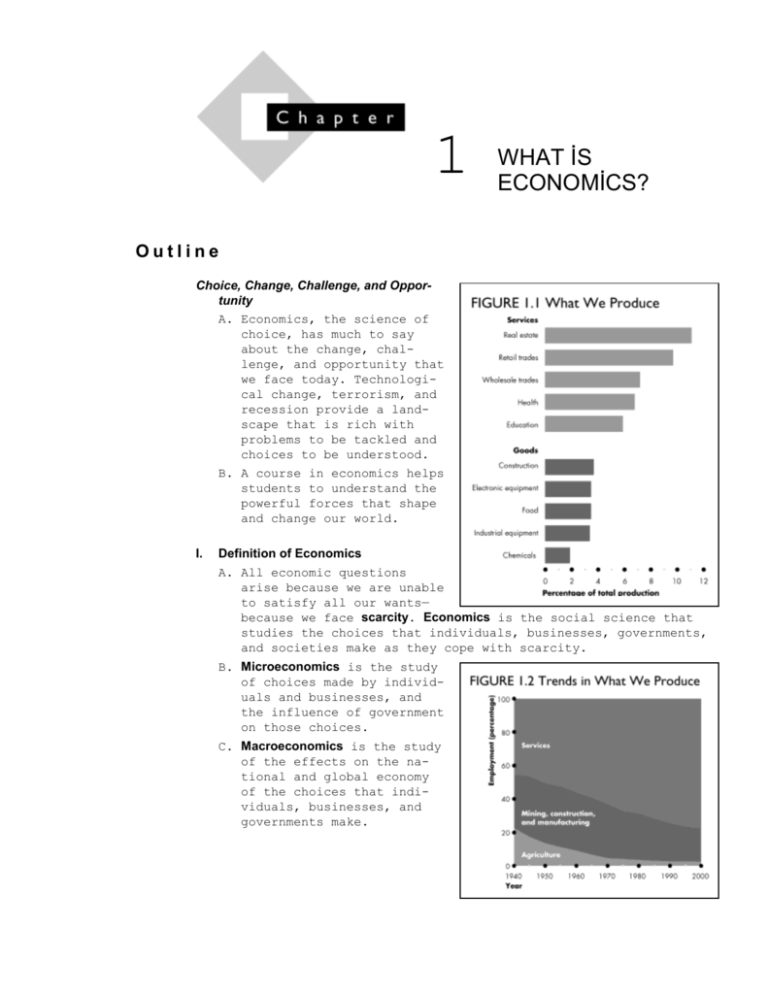
1 WHAT İS ECONOMİCS? Outline Choice, Change, Challenge, and Opportunity A. Economics, the science of choice, has much to say about the change, challenge, and opportunity that we face today. Technological change, terrorism, and recession provide a landscape that is rich with problems to be tackled and choices to be understood. B. A course in economics helps students to understand the powerful forces that shape and change our world. I. Definition of Economics A. All economic questions arise because we are unable to satisfy all our wants— because we face scarcity. Economics is the social science that studies the choices that individuals, businesses, governments, and societies make as they cope with scarcity. B. Microeconomics is the study of choices made by individuals and businesses, and the influence of government on those choices. C. Macroeconomics is the study of the effects on the national and global economy of the choices that individuals, businesses, and governments make. 2 CHAPTER 1 APPENDIX II. Three Big Microeconomic Questions A. What Goods and Services are Produced? 1. Figure 1.1 (page 3) shows the major items produced in the U.S. economy today. It emphasizes the dominant place of services in our economy. 2. Figure 1.2 (page 3) shows the trends in what the U.S. economy has produced over the past 60 years. It shows the decline of agriculture, mining, construction, and manufacturing, and the expansion of services. (These trends have been in place for the past 150 years.) 3. Microeconomics seeks to explain what goods and services are produced. B. How are Goods and Services Produced? 1. Factors of production are the resources that are used to produce goods and services. The “gifts of nature” that we use to produce goods and services are land. The work time and effort that people devote to producing goods and services is labor. The quality of labor depends on human capital, which is the knowledge and skill that people obtain from education, on-the-job training, and work experience. The tools, instruments, machines, buildings, and other constructions that are used to produce goods and services are capital. The human resource that organizes land, labor, and capital, innovates by creating new goods and services, makes business decisions, and bears the risks that arise from those decisions is entrepreneurship. 2. Figure 1.3 (page 4) shows a measure of the growth of human capital in the United States over the last century—the per- GRAPHS IN ECONOMICS 3 centage of the population that has completed different levels of education. 3. Microeconomics seeks to explain what determines the quantities of capital, labor, and other resources that get used to produce goods and services. C. For Whom are Goods and Services Produced? 1. Who gets the goods and services depends on the incomes that people earn. 2. Land earns rent, labor earns wages, capital earns interest, and entrepreneurship earns profit. 3. Figure 1.4 (page 5) shows the distribution of income in the United States. The richest 20 percent earn almost 50 percent of total income while the poorest 20 percent earn only 4 percent of total income. 4. Microeconomics seeks to explain what determines earnings and the distribution of income that in turn determines who gets the goods and services produced. III. Three Big Macroeconomic Questions A. What Determines the Standard of Living? 1. The standard of living is the level of consumption that people enjoy on the average and is measured by average income per person. 2. Figure 1.5 (page 6) shows income per person per day in a number of countries and regions. The United States has one of the highest standards of living, and the nations of Africa have the lowest. 3. Macroeconomics seeks to explain differences in the standard of living across countries and over time and the rate at which the standard of living grows. B. What Determines the Cost of Living? 1. The cost of living is the amount of money it takes to buy the goods and services that a typical family consumes. 2. Table 1.1 (page 7) shows the price of a Big Mac 4 CHAPTER 1 APPENDIX hamburger in a number of countries. 3. Inflation is a rising cost of living, and deflation is a falling cost of living. 4. Macroeconomics seeks to explain the forces that determine the cost of living and the inflation (or deflation) rate. C. Why Does Our Economy Fluctuate? 1. The business cycle is the periodic but irregular up-and-down movement in production and jobs in an economy. 2. Figure 1.6 (page 8) illustrates a stylized business cycle and the relationship between the phases and turning points of a cycle. An expansion (production and jobs increasing more rapidly than normal) begins at a trough and ends at a peak. A recession (production and jobs shrinking) begins at a peak and ends at a trough. 3. Macroeconomics seeks to understand the business cycle and explain the forces that bring expansion and recession. IV. The Economic Way of Thinking A. Choices and Tradeoffs 1. The economic way of thinking places scarcity and its implication, choice, at center stage and sees every choice as a tradeoff—an exchange—giving up one thing to get something else. “Guns versus Butter” is the classic tradeoff. B. Microeconomic Tradeoffs 1. The three microeconomic questions become sharper when we think in terms of tradeoffs. 2. “What?” Tradeoffs arise when people choose how to spend their incomes, when governments choose how to spend their tax revenues, and when businesses choose what to produce. 3. “How?” Tradeoffs arise when businesses choose among alternative production technologies. 4. “For Whom?” Tradeoffs arise when choices change the distribution of goods and services produced across individuals. Government redistribution of income from the rich to the poor creates the big tradeoff—the tradeoff between efficiency and equity. B. Macroeconomic Tradeoffs GRAPHS IN ECONOMICS 5 1. Macroeconomic questions also become sharper when we think in terms of tradeoffs. 2. Standard of Living Tradeoffs arise when we choose between current consumption and activities such as saving and investing, education, and research that increase future production and consumption possibilities. 3. An Output-Inflation Tradeoff arises when policymakers choose how much inflation to endure in order to maintain a high level of production. The output-inflation tradeoff arises because a policy action that lowers inflation also lowers output and a policy action that boosts output increases inflation. C. Opportunity Cost 1. Thinking about a choice as a tradeoff emphasizes cost is an opportunity forgone. The highest-valued alternative that we give up to get something is the opportunity cost of the activity chosen. D. Margins and Incentives 1. People make choices at the margin, which means that they evaluate the consequences of making incremental changes to the allocation of their resources. The benefit from pursuing an incremental increase in an activity is its marginal benefit. The opportunity cost of pursuing an incremental increase in an activity is its marginal cost. 2. Marginal benefit and marginal cost act as an incentive—an inducement to take a particular action. For any activity, if marginal benefit exceeds marginal cost, people have an incentive to do more of that activity; if marginal cost exceeds marginal benefit, people have an incentive to do less of that activity. Economists seek to predict choices by looking at changes in incentives. V. Economics: A Social Science A. Economics is a social science. Economists distinguish between statements that are positive (what is and can be tested) and normative (what ought to be and cannot be tested). B. Model Building 1. Economists observe and measure economic activity, build economic models, and test their models. 2. An economic model is a description of some aspect of the economic world that includes only those features of the world that are needed for the purpose at hand. C. Testing Models 1. An economic theory is a generalization that summarizes what we think we understand about the economic choices that people make and the performance of industries and entire economies. D. Obstacles and Pitfalls in Economics 6 CHAPTER 1 APPENDIX 1. To build and test an economic model, the economist must overcome obstacles and avoid pitfalls. 2. Ceteris Paribus or “other things being equal.” Economists try to isolate cause-and-effect relationship by changing only one variable at a time, and hold all other relevant factors unchanged. 3. The fallacy of composition is the false statement that what is true for the parts is true for the whole or what is true for the whole is true for the parts. 4. The post hoc fallacy from the Latin term “Post hoc, ergo propter hoc”—means “after this, therefore because of this”; the error of reasoning that a first event causes a second event because the first occurs before the second. E. Agreement and Disagreement 1. Economists are often accused of contradicting each other. In contrast to the popular image, economists find much common ground on a wide range of issues. (Page 14 lists twelve different economic propositions that at least 70 percent of all economists polled will agree upon.)
